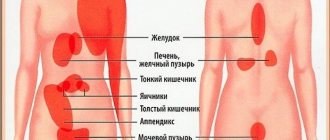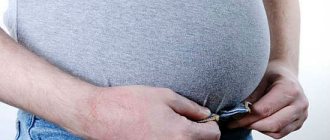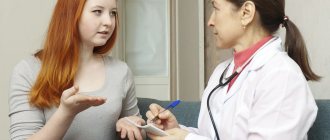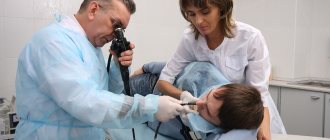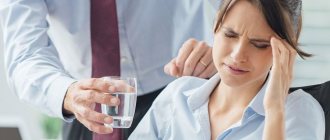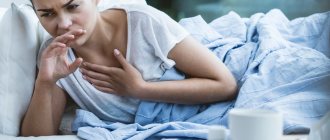The abdominal cavity contains the organs of the digestive, excretory, endocrine and reproductive systems. Therefore, complaints of abdominal pain are one of the most common reasons for patients to seek medical help.
Pain in the intestines in the left lower abdomen: causes and symptoms
When interviewing a patient, the specialist asks the patient about the nature, duration and location of pain. This information allows you to identify possible disorders in the body and make a preliminary diagnosis. However, it is often possible to establish an accurate diagnosis only with the help of instrumental or laboratory tests, since a clinical examination does not allow obtaining a sufficient amount of data about the patient’s condition.
Causes of abdominal pain
| Nature of abdominal pain | Possible pathology |
| Cutting pain that persists for a long period | Ulcerative colitis, neoplasms of the reproductive system, tumor process, endometritis |
| Sudden onset excruciating pain | Ulcer, aneurysm of a large vessel, movement of stones along the ureters |
| Intense pain syndrome of a constant nature | Intestinal obstruction, thrombosis of blood vessels of the abdominal organs |
| Gradually increasing pain syndrome | Appendicitis, cholecystitis, pancreatitis |
| Colicky pain that persists for a long period of time | Small intestinal obstruction, chronic pancreatitis, flatulence |
Organs in the abdominal cavity
Ulcerative colitis
Ulcerative colitis is a chronic disorder of the intestines in which the inflammatory process affects the intestinal walls. Pathology can arise as a result of various factors and is characterized by frequent relapses. As the disease progresses, ulcerated and necrotic areas form on the mucous membranes of the digestive tract.
What is ulcerative colitis and its symptoms
With ulcerative colitis, the pain syndrome is most often localized in the left lower abdomen, which is due to the peculiarities of the anatomy of the intestine. In addition, patients also experience the following symptoms of pathology:
- intense long-lasting pain syndrome, which is localized in the abdomen on the left side;
- loose stools with mucous or bloody inclusions;
- frequent false urge to defecate;
- hyperthermia up to 37.5-39°C, during which the patient experiences bouts of sweating, fever, chills;
- loss of appetite;
- dehydration;
- pain in the joints and muscles, which is especially aggravated by fever;
- fatigue, weakness, apathy.
Attention! If left untreated, ulcerative colitis can lead to necrotic changes in intestinal tissue and perforation of the intestinal wall. This pathology causes the effusion of feces into the abdominal cavity and the development of peritonitis.
Symptoms of peritonitis
When treating patients with ulcerative colitis, the main goal of treatment is to achieve long-term remission of the disease. To stop the inflammatory process, aminosalicylates are used: Colazal, Mesalamine, Azulfidine . If the disorder is of autoimmune origin, then to eliminate it it is necessary to use chemotherapy: Methotrexate, Mercaptopurine, Azathioprine . If necessary, therapy with steroids is also carried out, for example, Megadexane, Prednisol or Medrol .
The drug Medrol
Patients with ulcerative colitis are advised to follow a special diet that excludes from the patients’ diet all foods that can cause fermentation or injury to the intestinal wall. In this case, daily meals should be divided into 5-6 small portions so as not to stimulate excessive intestinal motility.
Intestinal obstruction
Intestinal obstruction or intussusception is a syndrome that has a polyetiological nature, that is, it develops against the background of various diseases and pathologies. This disorder is characterized by a disorder of passage, that is, movement, of feces through the intestinal lumen. The pain can be localized in different areas of the abdomen, depending on which part of the digestive tract is affected. Most often, patients complain of pain in the left side of the abdomen.
Intussusception
With intestinal obstruction, obturation occurs, that is, blockage of the intestinal lumen with feces, which causes swelling and spasm of the intestinal walls. Gradually, in the absence of therapy, blood flow is disrupted, acute inflammation and infection of the body occurs.
Attention! Prolonged bowel dysfunction provokes the absorption of waste products from feces into the blood. As a result, general intoxication of the body occurs.
When examining patients with intestinal obstruction, specialists note a number of characteristic signs of pathology:
- discomfort in the abdomen, usually localized somewhat to the left of the navel;
- absence of bowel movements or rare small stools in the form of separate hard pieces;
- vomiting of food and bile, and after 2-3 days of illness - intestinal contents;
- pronounced peristalsis;
- upon palpation, the abdomen is hard and tense; in some cases, the specialist is able to palpate the accumulation of feces in the intestines;
- the abdomen takes on an asymmetrical shape, protrudes at the site of the lesion;
- upon percussion, rumbling and seething in the abdomen is noted;
- dehydration;
- Patient complaints of thirst, dry mouth.
Schematic representation of the intussusception of the intestine
A few days after the development of the disease, the patient experiences severe abdominal pain. They are dull or spastic in nature and grow at the height of the peristaltic wave. In the absence of help, the patient develops intoxication and shock, which is manifested by a sharp drop in blood pressure, pallor of the skin, an attack of cold sweat and tachycardia. A patient in this condition urgently requires hospitalization.
Attention! In some cases, a few days after the onset of intestinal obstruction, the patient stops complaining of pain, despite persistent constipation. This is an alarming symptom, indicating the death of nerve endings in the intestinal walls and the development of necrotic processes.
Treatment methods for this pathology directly depend on the cause of the obstruction. For atony of the intestinal tract, the patient is prescribed drugs to stimulate peristalsis: Bisacodyl, Guttalax, Proserin . When intestinal spasticity occurs, the patient needs to take antispasmodics: No-shpu, Papaverine, Drotaverine . In most cases, people with this disease require intestinal lavage.
The drug Papaverine in the form of suppositories
If conservative therapy does not bring the desired effect or the pathological process provokes tissue necrosis, then surgical intervention is indicated for the patient. Depending on the etiology of the obstruction, the doctor may perform the following manipulations:
- remove part of the affected intestine during a necrotic process or the formation of a tumor and adhesions;
- correct a knot, hernia or volvulus;
- with the development of an extensive infectious process, drainage of the intestines and abdominal cavity is performed;
- In case of heavy accumulation of feces in the intestine, the surgeon manually removes the fecal plug.
Attention! In order to prevent a recurrence of an attack of intestinal obstruction, it is necessary to establish the cause of its development in a given patient.
Video - Why does the left lower abdomen hurt?
Flatulence
Flatulence is a common disorder of the digestive system and is one of the most common syndromes of gastrointestinal diseases. With this pathology, the patient experiences flatulence, that is, excessive gas production. Normally, the human body produces from 0.2 to 0.5 liters of intestinal gases, and with flatulence their volume often exceeds 2-3 liters.
Diagram of flatulence in the intestines
This disorder occurs in healthy people as a result of some physiological reasons: overeating, consumption of fermentable foods, constipation, etc. In patients with gastrointestinal dysfunction, this condition occurs due to disruption of the processes of gas formation and removal. In this case, patients are usually bothered by the following symptoms:
- bloating; upon palpation, the abdominal wall is elastic and hard;
- belching, hiccups;
- nausea, heartburn;
- constant passing of gases with a rotten or putrid odor;
- spasmodic pain in the intestines;
- bowel dysfunction, with diarrhea giving way to constipation;
- general feeling of poor health, shortness of breath, feeling of heaviness in the abdomen.
The drug Mezim Forte to improve digestion
Therapy for this condition is aimed at identifying the underlying disease and its further treatment. Often, flatulence is caused by maldigestion, that is, a violation for one reason or another of the normal digestion and absorption of nutrients. As a result, fermentation begins in the intestines and, as a result, the formation of excess gases. To stop this pathology, the patient is prescribed Mezim Forte, Festal, Digestin and other drugs to normalize digestion.
Patients are also advised to follow a diet that excludes the consumption of excess amounts of foods that lead to fermentation or rotting, that is, legumes, cabbage, fatty meats, fresh baked goods, etc.
Foods that cause flatulence
Treatment
The course of treatment will depend on the underlying cause. The pharmacological part of therapeutic measures includes taking several drugs, since taking any one medicine for pain in the intestines is impractical.
- antispasmodics;
- painkillers;
- antiviral;
- antibiotics;
- non-steroidal anti-inflammatory drugs;
- antibacterial;
- vitamin and mineral complexes;
- sorbents;
- probiotics, prebiotics;
- anthelmintic.
A diet for intestinal pain is mandatory. Nutrition will be aimed at improving the functioning of the gastrointestinal tract, so the diet should be light, but at the same time containing all the necessary vitamins and minerals.
If treatment is started promptly and correctly, this syndrome can be eliminated quite quickly. However, it should be noted that further prognosis will depend on the disease itself.
As for prevention methods, in this case it is advisable to carry out measures to prevent those etiological factors that have such a symptom in the clinical picture.
Source of the article: https://okgastro.ru/simptom/1259-boli-v-kishechnike
Tumor processes in the intestines
Tumors of various origins in the intestine are quite difficult to diagnose. In most cases, such a neoplasm can be detected in two cases:
- when conducting various instrumental studies to determine other pathology;
- when a patient consults a doctor as a result of pain in the intestines.
Attention! The main danger of tumor processes in the intestinal tract is the late appearance of symptoms. Pain syndrome occurs when the tumor has already reached a large size and blocks the intestinal lumen or begins to affect surrounding tissues.
Diagnosis of tumor processes in the intestines
An enlarging tumor causes destruction of the intestinal walls, causing discomfort. Initially, the pain is mild and occurs sporadically. Gradually its intensity increases, the patient cannot relieve pronounced discomfort with analgesics. In addition to pain, a person also experiences a number of other symptoms:
- bloating and tension in the abdomen, while palpation is painful for the patient;
- weight loss, which gradually leads to cachexia – depletion of all the body’s resources;
- lack of appetite;
- weakness, lethargy, drowsiness;
- apathy or nervousness;
- anemia, against the background of which the patient experiences pallor and thinning of the skin;
- constant feeling of heaviness in the stomach, heartburn;
- nausea and vomiting, including intestinal contents;
- bowel dysfunction, with the possibility of both diarrhea and prolonged constipation;
- intestinal obstruction as a result of tumor growth;
- peritonitis due to rupture of the intestinal wall;
- melena - dark or black stool with blood;
- the appearance of mucus or purulent inclusions in feces;
- pain when trying to have a bowel movement;
- belching, frequent hiccups, constant increased gas production.
Colon tumors
Therapy for benign intestinal tumors in most cases is based on their surgical removal. Malignant neoplasms must be treated comprehensively, and the patient is advised to use cytostatics, radiation therapy and, if possible, surgery.
Chemotherapy is divided into adjuvant and neoadjuvant. In the first case, cytostatics are administered to the patient to reduce the tumor or reduce the number of metastases before radical surgery. Neoadjuvant drug treatment is carried out after surgery to destroy pathogenic cells in the patient's body. Today, the drugs most often used to relieve intestinal tumors are 5-fluorouracil, Oxaliplatin, and Capecitabine .
The drug Oxaliplatin
Attention! When taking chemotherapy, you must carefully follow your doctor's recommendations, as these drugs have many side effects. To reduce the likelihood of various unpleasant consequences to a minimum, during treatment it is necessary to lead a healthy lifestyle, eat right and take vitamin and mineral complexes.
In some cases, radiation therapy is also used to shrink the tumor. Its action is aimed directly at the tumor. During this procedure, ionizing radiation has a destructive effect on malignant cells, causing their destruction. In most cases, radiation therapy is used as preparation for surgery or to provide palliative care to patients with inoperable tumors.
Surgical removal of the tumor is one of the most radical and effective treatment methods. However, it makes sense to perform surgery only if it is possible to remove all or most of the tumor. With extensive metastasis, the patient initially requires a course of chemotherapy.
Development of rectal cancer
It should be noted that the choice of treatment methods, the type and scheme of use of certain pharmacological drugs will be determined by the attending physician, based on the clinical picture of the disease and the individual characteristics of the patient.
Video: How to understand that you have a tumor or polyps in the intestines
Treatment of pain in the intestines on the right and left lower abdomen
To determine the cause of severe pain in the intestines on the left and right side of the lower abdomen, the patient should visit a doctor. After the initial examination and consultation, the patient will be sent for testing. A general analysis of blood, urine and feces will show the internal indicators of the body and demonstrate the presence of any abnormalities in the systems of the human body.
For clearer results, the patient is referred for a bacteriological examination of stool, colonoscopy and endoscopic examination. After receiving the test results, the attending physician prescribes treatment for the patient. A medical expert prescribes medication, homeopathic or surgical intervention in advanced cases.
If necessary, to obtain information about the condition of the internal organs, the doctor refers the patient to undergo a computed tomography or ultrasound scan. These diagnostic tests are not recommended for pregnant women, nursing mothers, and children under sixteen years of age. Health care professionals do not recommend these procedures for certain groups of the population. The use of radiation and contrast fluid can negatively affect healthy organs.
To make an appointment for a consultation or examination at the private clinic “KDS Clinic”, leave a request on the website and managers will contact you as soon as possible.
Diverticulitis
Diverticulitis is a disease of the digestive tract in which the inflammatory process leads to the formation of specific protrusions of the intestinal wall - diverticula. Diverticulitis develops due to congestion in the digestive system. Moreover, the disease is approximately one and a half times more common in women than in men.
Colon diverticulum
Pathology can have a different etiology, but most often occurs with a diet that is deficient in fiber. In recent decades, the incidence of diverticulitis has increased as people began to consume much more baked goods and processed meats at the expense of plant foods.
This disorder also affects people with dysbiosis or impaired immune system function. One of the most common causes of diverticulitis is helminthic infestation, in which irritation and destruction of the intestinal wall by helminths occurs, due to which pathogenic bacteria contained in the stool begin to invade the intestinal tissue and provoke inflammation.
Attention! In the incidence of diverticulitis, the hereditary factor is of great importance. In people whose immediate relatives suffer from this pathology, the likelihood of developing the disease increases by an average of 3-4 times.
This is what the intestines look like with diverticulitis
In addition to dull or aching pain in the abdomen, mainly on the left side, the following symptoms are also noted with diverticulitis:
- persistent monotonous pain syndrome localized at one point;
- bowel dysfunction, characterized by alternating diarrhea and constipation;
- the appearance of scarlet or burgundy bloody inclusions in the stool;
- hyperthermia up to 37.5-38°C, caused by an inflammatory process in the intestinal mucosa;
- a sharp increase in discomfort when palpating the affected area;
- loss of appetite, nausea, possible vomiting.
Therapy for diverticulitis is carried out on an outpatient basis in cases where a specialist during diagnosis does not detect a severe infectious process or signs of peritoneal irritation. The patient is prescribed antibacterial drugs: Cefoxitin, Timentin , etc. To relieve inflammation, agents with antimicrobial and anti-edematous effects are used: Mesalazine, Salofalk. Drotaverine, No-shpa, Nise, Novigan are also used to relieve spasms and reduce pain.
The drug Drotaverine for relieving spasms
Discomfort in the intestines often signals the development of various pathologies of the digestive tract. In order to promptly identify the disease and begin treatment, it is necessary to consult a specialist when the first symptoms appear. Due to a runny nose, my ear is blocked; read what to do on our website.
Pain in the left side of the abdomen and bloating in women: causes
First, we should note the most common cause of nagging or cramping abdominal pain in women - menstruation. Sometimes pain in the lower abdomen can occur in the middle of the menstrual cycle, which can signal the onset of ovulation. Also, abdominal pain of various types can appear in a woman during pregnancy, especially in the first and third trimesters.
Finally, pain in the left side of the abdomen and severe bloating can be caused by a disease such as endometriosis. With this disease, there is an active proliferation of endometrial cells that make up the inner layer of the uterus. The disease is provoked by infections, inflammatory processes in the reproductive system, anemia, smoking or regular consumption of alcoholic beverages. It is often asymptomatic and occurs against a background of weakened immunity.
Listed below are the causes of pain in the left side and abdomen, which occur in both women and men, but in the former it is somewhat more common.
The list includes:
- Stones in the ureter. In this case, pain occurs first in the left side, after which it radiates down the abdomen. The patient cannot even always point to the original point from where the pain spread;
- Osteochondrosis of the chest. The disease is included in the section of degenerative-dystrophic disorders and it is very difficult to notice it in the early stages. When an intervertebral hernia forms, a person begins to suffer from pain, including in the abdomen and left side;
- Endometriosis, already described above;
- Diseases of the genitourinary system. Their peculiarity is that pain occurs in the lower abdomen, but often it can spread to the left side. Among these diseases: Inflammation of the fallopian tube;
- Twisting or rupture of the ovarian stalk. This pathology can be very dangerous and its treatment should be started as quickly as possible;
- Ectopic pregnancy (causes pain similar in nature to that occurring with prostatitis in men).



